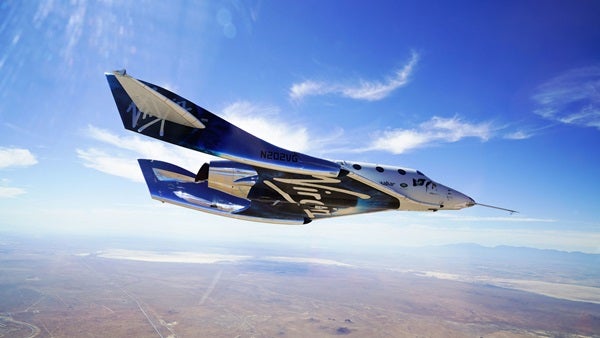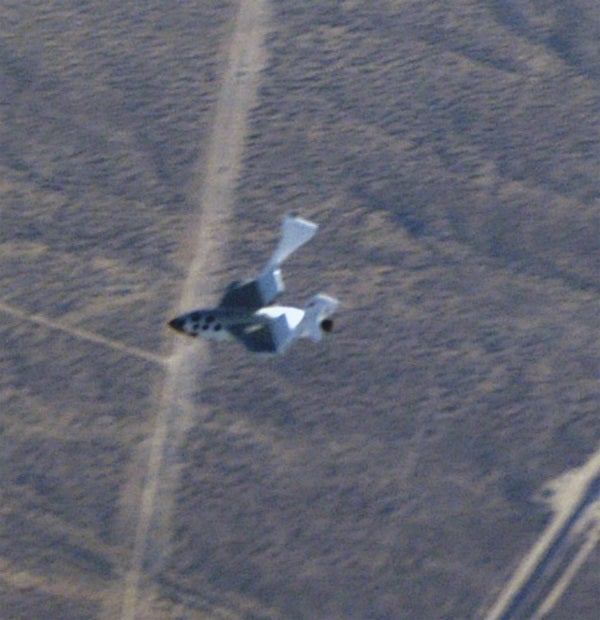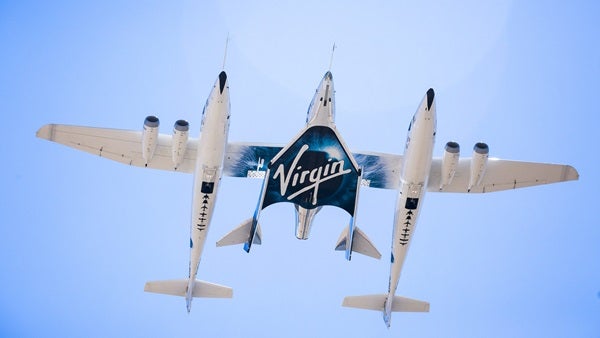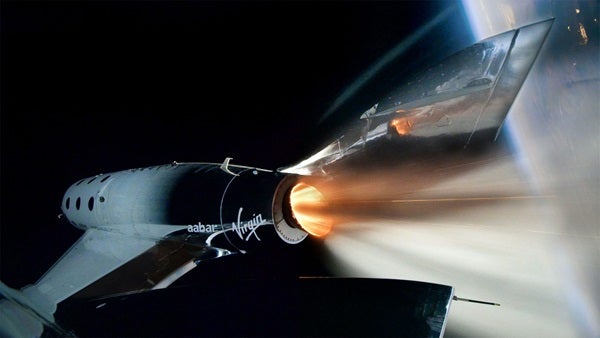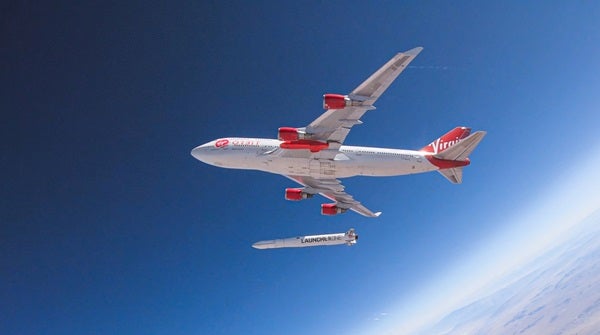While most governments and private companies have chosen to reach space using traditional vertically launched rockets, there’s one private space company that has taken a completely different approach: Virgin Galactic. Using an unconventional spaceplane and cutting-edge technology, Virgin Galactic has completely reimagined how to put humans and payloads into space.
Founded by billionaire and industry magnate Richard Branson, Virgin Galactic has stated that its aim is to put people into space for both personal tourism and scientific research. Founded in 2004, the company has repeatedly made headlines with its unconventional approach to spaceflight. However, Virgin has taken a path that has proven to be much tougher than expected. Along the way they have scored some stunning “firsts,” but suffered some tragic failures as well.
SpaceShipOne and the Ansari X Prize
Instead of using traditional rockets that take off from the ground, Virgin Galactic has heavily invested in air-launched spaceplanes that are carried aloft by a much larger “mothership” aircraft (similar to the manner in which the X-15 operated). Virgin Galactic grew out of an effort in the early 2000s by famed aircraft designer Burt Rutan and his company Scaled Composites to win the Ansari X Prize — a $10 million award to the first private organization to launch a craft into space twice within two weeks. Rutan’s effort, unveiled in 2003, was SpaceShipOne. The spaceplane featured had what has been termed a “shuttlecock” design: The rear section of the wings could be pneumatically tilted upward, or “feathered,” to increase the stability of the craft during reentry into the Earth’s atmosphere.
SpaceShipOne was carried from the ground by its mothership, known as White Knight One, to an altitude of approximately 45,000 feet before being dropped. After a brief period of gliding and descending away from White Knight One, SpaceShipOne ignited its engine — a hybrid rocket engine that used both solid and liquid fuels — and ascended at an angle of 65 degrees from the ground.
SpaceShipOne ultimately could reach a speed of Mach 3.5 and, once the engine was cut off, would continue to ascend above 62 miles (100 kilometers) — the internationally recognized boundary of space, also known as the Karman Line. While coasting, its occupants would experience a brief period of weightlessness before the craft’s parabolic course brought it back down to the upper layers of the atmosphere.
At the apogee of its course, SpaceShipOne raised its wing to allow for a more controlled reentry. After entering the atmosphere, it lowered its wing and glided to a controlled landing on a runway. SpaceShipOne claimed the Ansari X Prize in 2004 and currently hangs in the “Milestones of Flight” gallery at the National Air and Space Museum in Washington, D.C.
SpaceShipTwo: triumph and tragedy
Just days before SpaceShipOne’s successful X Prize campaign, Richard Branson announced the formation of Virgin Galactic. The spaceline would license Scaled Composites’ technology and commission it to build a second-generation spacecraft: SpaceShipTwo.
Designed to carry a crew of eight (two pilots and six passengers), SpaceShipTwo has a very similar flight profile to that of SpaceShipOne. It’s carried from the ground by its mothership, White Knight Two, and, after separating and firing its engine, is designed to reach an altitude of 68 miles. Both SpaceShipTwo and White Knight Two are roughly double the size of their predecessors.
Despite its promise, SpaceShipTwo has experienced several significant setbacks that cost lives. In 2007, a rocket motor test resulted in an explosion that took the lives of three people, with three others being seriously injured.
And in 2014, one of the two SpaceShipTwo crafts, known as VSS Enterprise, was lost during a powered flight. Its takeoff and release from its mother ship was uneventful. But 11 seconds after Enterprise ignited its rocket motor, the ship broke apart. Pilot Peter Siebold was thrown free of the craft at an altitude of over 9 miles and a speed in excess of Mach 1 wearing only his flight suit. Siebold sustained numerous fractures and injuries to his eyes but survived the loss of the vehicle; he was able to parachute to the ground. His co-pilot, Michael Alsbury, was unable to escape the craft and was found dead in his seat in the wreckage.
The National Transportation and Safety Board (NTSB) investigated and found that the wing had been feathered during the boost phase of the flight, resulting in the ensuing loss of the vehicle. The NTSB issued a report citing numerous failures on the part of Scaled Composites. One of the factors was human error: The copilot unlocked the wing feathering system too early and at too low a speed — around Mach 0.9 to 1.1, a transitional range of speeds where airflow across the craft’s surfaces is supersonic in some places and subsonic in others. This caused the wing to feather on its own, causing inertial and aerodynamic loads on the craft that resulted in structural failure.
However, pilot error wasn’t the only factor. The NTSB also found Scaled Composites had failed to consider potential human errors in designing the craft’s controls and systems. And, the report said, there was only limited interaction between Scaled Composites and the FAA during the experimental permit application process; more oversight could have potentially found and rectified those failures.
Picking up the pieces
After the loss of SpaceShipTwo, Virgin Galactic soldiered on. Having built up its own in-house technical expertise, it took over development and testing from Scaled Composites (which has since been purchased by Northrup Grumman). The surviving SpaceShipTwo, VSS Unity, has made two successful suborbital spaceflights, one of which carried a passenger. More flights are planned, and the company’s website contains a page on which people can sign up to be passengers on future spaceflights. The exact price of a ride on a Virgin Galactic flight is unclear, but the company says its original price of $250,000 is no longer valid. Users are asked to suggest a price they would be willing to pay, up to $1 million.
In March 2021, Virgin Galactic also unveiled its first vehicle in its SpaceShipThree class — an upgraded version of SpaceShipTwo designed for easier maintenance.
Beyond Virgin’s crewed spaceflight division, a sister company called Virgin Orbit has also developed the means to put small payloads into orbit. The air-launched two-stage rocket, known as LauncherOne, is dropped from a modified Boeing 747. The launcher is designed to carry small, nonhuman payloads up to 300 kg into a sun-synchronous orbit or 500 kg into low earth orbit. LauncherOne has flown twice to date, one time successfully and one time with an early shutdown of its first stage.
Here to stay?
Despite the uncertainty inherent in spaceflight, and stiff competition from SpaceX, Blue Origin, and other companies, Virgin Galactic shows no sign of getting out of the space business. The company has constructed a base at Spaceport America in Mojave, New Mexico, making it a hub of its activities. The spaceport features an enormous terminal and hangar as well as a 12,000-foot runway.
To date, fewer than 600 humans have ever crossed the threshold into space. Virgin Galactic aims to make that number much higher, but when they will start offering flights to paying passengers remains unclear. There is no shortage of people interested in making such journeys, and to date over 600 individuals have paid to hold spots on future flights. Time will tell how many of them ever reach the stars.

